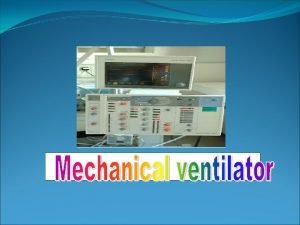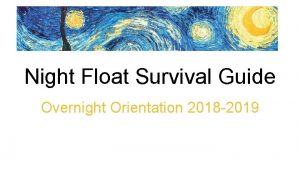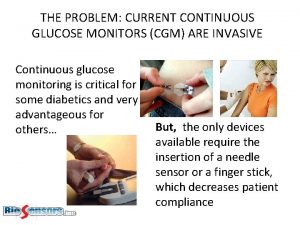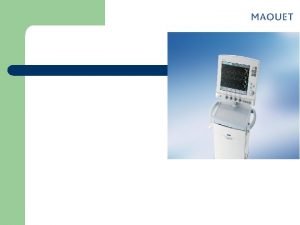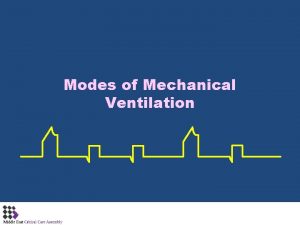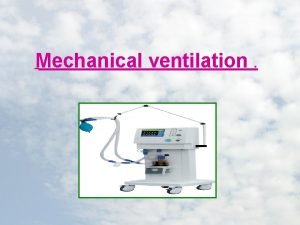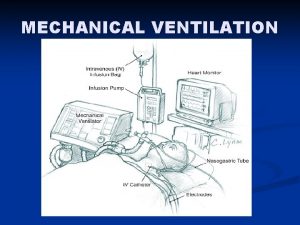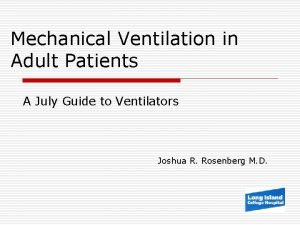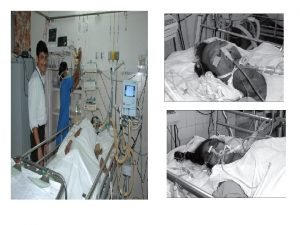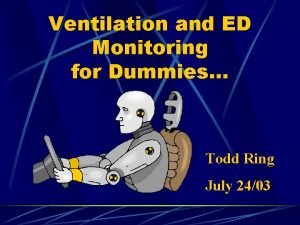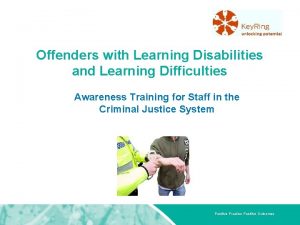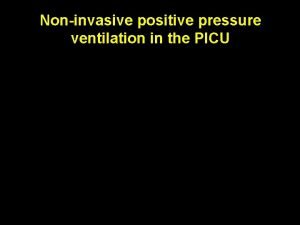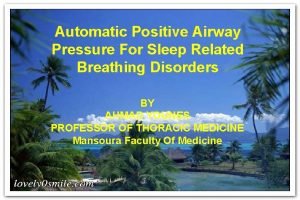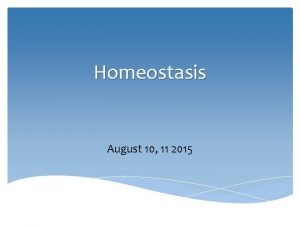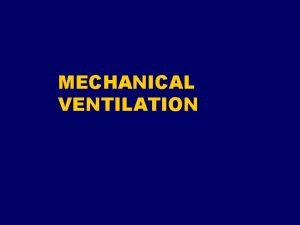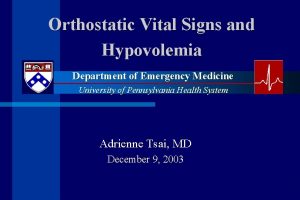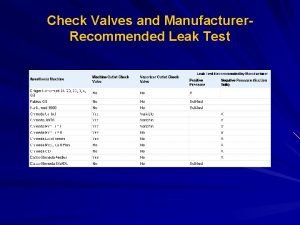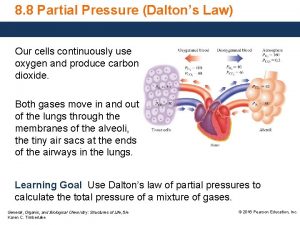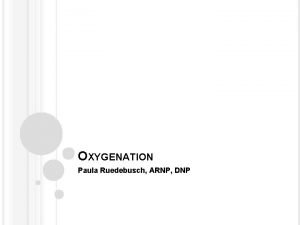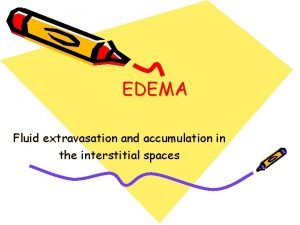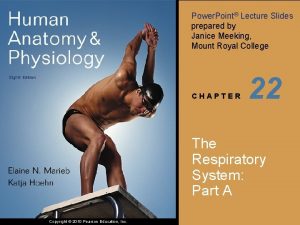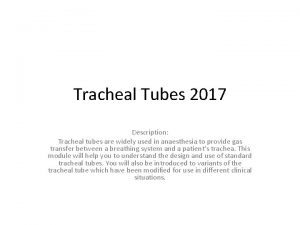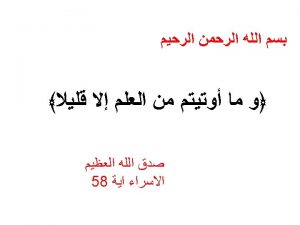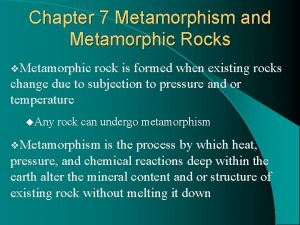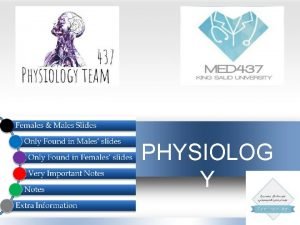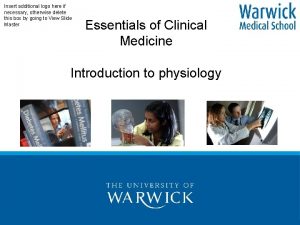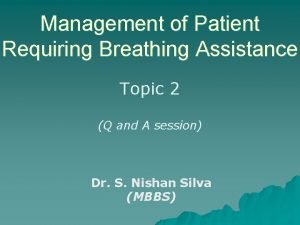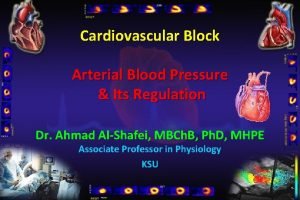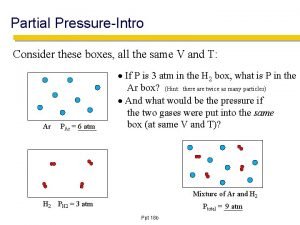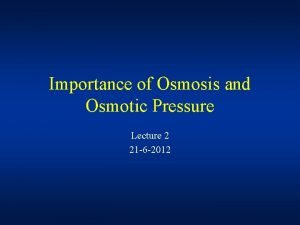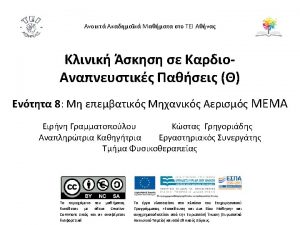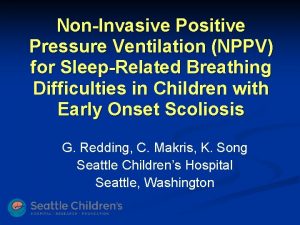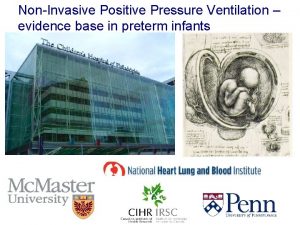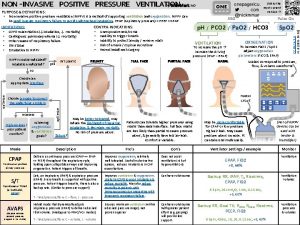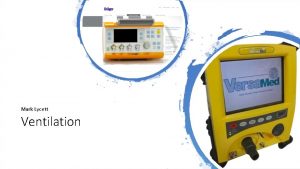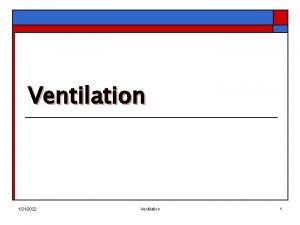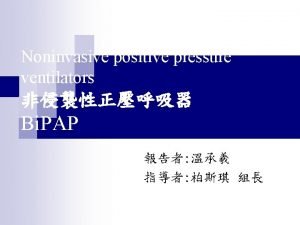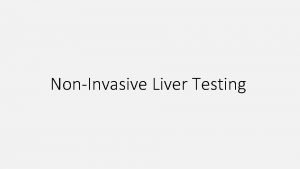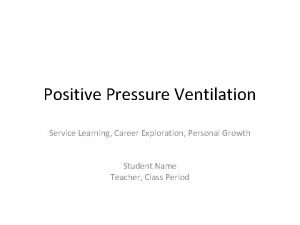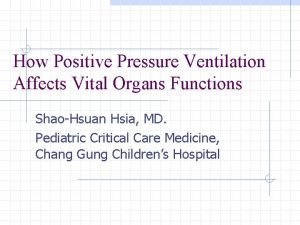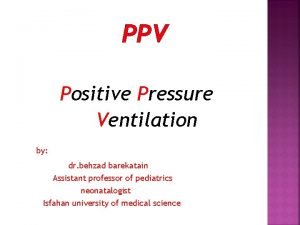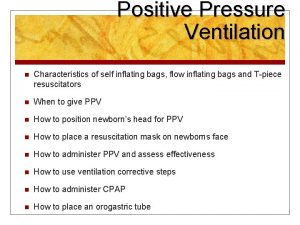Noninvasive positive pressure ventilation in the PICU What





















































- Slides: 53

Non-invasive positive pressure ventilation in the PICU

What is the daily practice of mechanical ventilation in ICU In adults (in the years 1996 / 1997: Esteban A et al. AJRCCM 2000; 161: 1450– 1458 In pediatrics (in the year 1999): ETT in 635 (96%; 95% CI: 94– 97) of patients, tracheostomy in 11 (2%; 95% CI: 1– 3), facial mask in 10 (1. 5%; 95% CI: 1– 3). Farias A et al. Intensive Care Med 2004; 30: 918– 925

NIPPV in the Pediatric Intensive Care Unit Geneva experience 1998 - 1999 Number of pediatric patients hospitalized in the PICU over a 2 -year period: General pediatrics: Cardiovascular surgery: General surgery: Neurosurgery: Transplantation unit: Onco-hematology: Orthopedics: 771 215 279 133 69 27 13 35 (28%) (36%) (17%) (9%) (3%) (2%) (5%) Ventilated patients: 479 (62%) Intubated and ventilated patients: 416 (87%) Ventilatory support with NIPPV or CPAP 63 (13%)

NIPPV in acute pediatric respiratory failure Geneva experience 1998 - 1999 n = 63 CPAP: NPPV (Bi. PAP): NPPV and CPAP: 30 29 4 Etiology: - infectieuse pneumopathy: n = 20 - resp. insuffiency postoperatively: n = 10 (orthopedic surgery: n = 3; diaphragmatic palsy: n = 5) - upper airway obstruction: n = 4 (incl. postextubation stridor) - acute heart failure: n = 16 (postoperative CHD, cardiomyopathy, myocarditis) - septicemia: n = 4

High risk of respiratory distress in infants and small children Small airways = high airway resistance Compliant chest wall = low FRC Relatively “inefficient” diaphragm The diaphragm should set off the inward motion of the rib cage to maintain tidal volume constant, something which it can only do to a limited extent and will result in paradoxic thoraco-abdominal movements. Chest wall distortion represents a pressure-induced change in volume and constitutes waste work which has an enormous energy cost

Objectives of Noninvasive Ventilation in Pediatric Patients With Respiratory Disorders Avoid intubation Teague WG Pediatric Pulmonology 2003; 35: 418– 426

Indications / Benefits of NIPPV in the PICU Early case reports showed: Improvement of clinical manifestation of respiratory distress and respiratory gas exchange in children with AHRF Avoid or delay endotracheal intubation ? Treatment of upper airway obstructions (stenting the airways) Treatment of atelectasis Treatment of exacerbations of neuromuscular disease Facilitation of weaning from invasive ventilation (e. g. post-operative in patients with restrictive lung disease)

NIPPV in acute hypoxic respiratory failure: Benefit and treatment failures in 3 pediatric case series 4 Rimensberger PC Swiss Medical Weekly 2000; 130: 1880– 6

NIPPV / CPAP in ARF: Treatment failures Geneva experience 1998 - 1999 6 / 63 (9. 5 %) on CPAP patient # 1 (4 months): patient # 2 (10 months): patient # 3 (6 months): on NPPV (Bi. PAP) patient # 4 (3 years): patient # 5 (15 years): patient # 6 (15 years): Bronchiolitis and BPD DORV, Tetralogy of Fallot: postoperative TGV, VSD postoperative BT-shunt ARDS, pneumonia Fungal pneumonia and sepsis in immuncompromised patient post lung transplantation Orthopedic patient with postoperative paraplegia

NIPPV in infants with AHRF 6 infants with AHRF of various etiology Pressure support: IPAP 14 ± 0, 5 cm. H 2 O; EPAP 7, 3 ± 1 cm. H 2 O Ti max: 0, 6 ± 0, 1 s ; insp. rise time: 100 ms. p. CO 2 RR F. Vermeulen et al. Annales Françaises d’Anesthésie et de Réanimation 2003; 22: 716– 720

NIPPV in children upper airway obstruction chronic: obstructive sleep apnea (OSA) a) anatomic obstruction of nasopharyngeal airways b) intermittent collapse of the nasopharyngeal airway - CPAP or NIPPV to prevent upper airway collapse acute: infectious conditions (epiglotitis, croup) or foreign body - CPAP or NIPPV works well in postextubation croup No published experience with helium and NIPPV in these conditions

PEEP: Tracheomalacia No PEEP 10 cm. H 2 O Quen Mok, Great Ormond Street Hospital for Children, London

CPAP: Tracheomalacia No PEEP CPAP 10 cm. H 2 O Quen Mok, Great Ormond Street Hospital for Children, London

Case serie in pediatric status asthmaticus with severe Teague WG AJRCCM 1998; 157: 542 hypoxemia prospective, non controlled case serie (n = 26) NPPV: nasal mask; S/T mode IPAP 13 ± 3 cm. H 2 O; EPAP 7 ± 2 cm. H 2 O; Fi. O 2 0. 68 ± 0. 28 Results: 21 ± 27 hrs mean duration 169 ± 183 hrs O 2 requirements 19/26 acutely improved 7/26 required intubation 11/26 did not well tolerate p. H pa. CO 2 (mm. Hg) pa. O 2 (mm. Hg) pre-tx (n = 15) 7. 36 ± 0. 5 40 ± 10 87 ± 23 post-tx (n = 6) 7. 42 ± 0. 9 39 ± 14 94 ± 35 p > 0. 05 for all comparisons

NPPV in pediatric status asthmaticus: Case serie * * p < 0. 05 not intubated (19) * p < 0. 05 intubated (7) The oxygen response test? Teague WG AJRCCM 1998; 157: 542 • was safe • allowed to shorten the length of ICU and hospital stay • did not prevent intubation in a subset of patients

NIPPV / CPAP in Bronchiolitis with Acute Hypoxic-Hypercapnic Respiratory Failure Geneva experience 1998 - 1999 retrospective chart review (1998 - 1999) n = 14 (age 5. 2 ± 3. 9 months; range: 1. 5 - 12) 2 patients with BPD syndrome - surfactant B deficiency - Wilson-Mikity- pre-treatment: p. H 7. 26 ± 0. 05 (range: 7. 17 - 7. 33) p. CO 2 76 ± 9 mm. Hg (range: 61 - 88) t. SO 2 60 ± 11 (range: 40 - 80) at room-air

NIPPV / CPAP in Bronchiolitis with Acute Hypoxic-Hypercapnic Respiratory Failure Geneva experience 1998 - 1999

NPPV in acute cardiogenic pulmonary edema (ACPE) (patients who responded were hypercapnic, those who failed were hypoxemic non-hypercapnic patients) with the exception of patients with acute myocardial infarction, CPAP and/or NPPV is efficient in ACPE with hypercapnic ARF

NPPV in acute heart failure and/or pulmonary edema Geneva experience 1998 - 1999

Perioperative use of noninvasive ventilation Non-invasive mask ventilation in 25 patients with respiratory failure preand/or postoperative Success rate of 68%, but different in respect to the varying causes of respiratory failure. CONCLUSION: With noninvasive mask ventilation it is possible to avoid in some patients with acute postoperative respiratory failure complications who are referred to intubation. In patients with postoperative decompensation of chronic respiratory failure postoperative treatment becomes easier, in extraordinary cases the method makes surgery possible. Karg O et al. Med Klin 1996; 91 Suppl 2: 38 -40

NIV for physiotherapy

NIV for physiotherapy

NIV for physiotherapy

NIV for physiotherapy

NIPPV in children with ARF: Complications severe: air leaks gastric perforation aspiration decrease in CO minor: skin irritation / skin breakdown nasal dryness conjunctivitis

Physiological Factors Unique to Pediatric Patients Promoting Complications of NIPPV Teague WG Pediatric Pulmonology 2003; 35: 418– 426

Indications et contre-indications de la ventilation non invasive en réanimation pédiatrique Indications Contre-indications Obstruction des voies aériennes supérieures Absolues Maladies pulmonaires primaires Œdème aigu cardiogénique Œdème aigu lésionnel Infection Arrêt cardiaque ou respiratoire Instabilité hémodynamique Patients à risque d'inhalation : encéphalopathie sévère, encombrement pharyngé quelle que soit l'origine , vomissements incoercibles, hémoptysies massives. Obstruction des voies aériennes inférieures Syndrome occlusif abdominal Syndrome thoracique aigu (drépanocytose) Allergie aux interfaces nasales et faciales Affections chroniques en décompensation aiguë (mucovicidose) Décompensation respiratoire aiguë de maladies neuromusculaires (amyotrophie spinale, dystrophie neuromusculaire) Affections congénitales et acquises avec altération aiguë du contrôle de la respiration Déformations thoraciques congénitales ou acquises (en péri-opératoire le plus souvent) Autres : anesthésie de courte durée, extubation précoce, échec d'extubation Relatives Évolutivité rapide de la défaillance respiratoire ou neurologique Patient non coopératif Lésions faciales Disponibilité insuffisante du personnel

NIPPV in children with ARF: Technical aspects setting: restricted to acute care units - pulsoxymeter - tcp. CO 2 / TECO 2 - cardiorespiratory monitoring

NIPPV in children with ARF: Technical aspects interface: soft preformed nasal mask appropriately sized usually work and are much better tolerated - chin strips can reduce the air leak

NIPPV in children with ARF: Technical aspects interface: soft preformed nasal mask appropriately sized usually work and are much better tolerated - chin strips can reduce the air leak

NIPPV in children with ARF: Technical aspects interface: soft preformed nasal mask appropriately sized usually work and are much better tolerated - chin strips can reduce the air leak alternatives: 1) nasal prongs (typically used in newborns and small infants) 2) full face (nasal-oral) masks - but increased risk of aspiration in small children (immature airway protective response)


NIPPV in children with ARF: Technical aspects DELIVERY SYSTEMS - CPAP devices for mask leaks need bias flow: to compensate to maintain constant airway pressure during in- and expiration - Volume-cycled devices need variable flow (pressure controlled / pressure targeted) should be able to deliver high inflation flows: - to allow to match inspiratory flow demands of the patient to reduce WOB, - to compensate for leaks need automated cycle feature (apnea)

NIPPV in children with ARF: Technical aspects DELIVERY SYSTEMS - flow-triggered devices with independent adjustements of IPAP and EPAP one way expiratory valve to prevent rebreathing (EPAP regulates CO 2 elimination: minimum 3 cm. H 2 O)

NIPPV in children with ARF: Technical aspects ventilators: NIPPV ventilators (typ: Bi. PAP; mode: S/T) ICU ventilators (PC / Pressure support) sensitive flow trigger threshold one way expiratory valve to prevent rebreathing Not optimal for small children: - No back-up rate - Very low (5%) fixed expiratory trigger / flow termination at very low flows

Decision making • Mode and Settings • Level of support • Level of sedation Patient-ventilator asynchrony Patient • Hering-Breuer reflexes • Respiratory Muscle Weakness • Respiratory system mechanics • Pathology • Leaks Ventilator • Ventilator algorithms and control • Trigger signal • Cycling off • Rate and character of inspiratory flow • Intrinsic PEEP • Leaks

Patient-Ventilator Interaction Patient-ventilator asynchrony by inspiratory trigger insensivity

Insp effort trigger vent COPD PSV Ineffective effort (12) Ineff trig abrupt dec exp flow RR 24 RR 60 E. Kondili, G. Prinianakis and D. Georgopoulos

Pressure-Support and flow termination criteria The non synchronized patient during Pressure-Support (inappropriate end-inspiratory flow termination criteria) Nilsestuen J Respir Care 2005; 50: 202– 232.

Pressure-Support and flow termination criteria Increase in RR, reduction in VT, increase in WOB Nilsestuen J Respir Care 2005

NPPV in acute or chronic pediatric respiratory failure: Which mode, which device and which interface? Infant (0 - 12 months) Small child (12 - 24 months) > 24 months AHRF Nasal CPAP (nasal Nasal CPAP or NIPPV with nasal or prongs or mask) or NIPPV with nasal or full face mask NIPPV with a full face mask modified circuit Upper airway obstruction Nasal or nasopharyngeal CPAP or NIPPV by nasal mask CPAP or NIPPV Tracheobronchomalacia CPAP with relatively high pressure levels Chronic RF in neuromuscular disease NIPPV Congestive heart failure or acute pulmonary edema Nasal CPAP Nasal or full face CPAP or NIPPV

Helmet-delivered CPAP and/or non-invasive pressure support ventilation in children? Need high flows to flush the system to avoid CO 2 -rebreathing

Helmet-delivered NIPSV in children with acute hypoxemic respiratory failure (P/F ratio < 200) Piastra M et al. Intensive Care Med 2004; 30: 472 -476

Selection guidelines for NIPPV in pediatric ARF • Progressive respiratory failure or insufficiency in the absence of apnea or impeding cardiorespiratory collapse • Failure of NIPPV would not produce immediate morbidity or mortality • Relative cooperation (of a lethargic or sedated patient) • Adequate mask fit achieved

Selection guidelines for NIPPV in pediatric ARF: Contra-indications • Ongoing emesis • Excessive bronchial secretions • Acute facial trauma • Upper airway protection not intact

NIPPV in acute respiratory failure in children widespread use in PICU • commonly applied to Ø avoid intubation / reintubation Ø improve atelectasis (type I failure / AHRF) Ø Improve alveolar hypoventilation (type II failure) Ø facilitate early extubation (postoperative / restrictive lung disease - neuromuscular disease - scoliosis repair) despite popularity, therapeutic efficacy has never been evaluated

NIPPV in pediatric ARF 1) NPPV is safe in pediatric patients with ARF 2) NPPV can improve oxygenation in mild to moderate hypoxemic respiratory insufficiency 3) May be particularly useful in patients in whom intubation should be avoided current pediatric NIPPV questions: - does NPPV in ARF prevent or delay intubation? - in which type of respiratory failure should it be used? - does NIPPV reduce mortality in ARF in children? ( mortality rate = 15%) - are ventilators appropriate for small children?


Pressure CMV Pressure SIMV Bivent Mechanical Ventilation Time CPAP Pressure APRV Pressure Time Spontaneous Breathing Time

Modification of the tubing for the use in infants F. Vermeulen et al. Annales Françaises d’Anesthésie et de Réanimation 2003; 22: 716– 720

Indications for tracheostomy: 1) Upper airway obstruction 2) Long-term ventilation/pulmonary toilet 1) Upper airway obstruction Subglottic stenosis Congenital/acquired Tracheomalacia Congenital/acquired Tracheal stenosis Congenital/acquired Craniofacial syndromes Pierre-Robin sequence CHARGE syndrome Treacher–Collins syndrome Beckwith–Wiedemann syndrome Craniofacial and laryngeal tumours Cystic hygroma, haemangioma Bilateral vocal cord paralysis Hydrocephalus internus Moebius syndrome Obstructive sleep apnoea Laryngeal trauma Burn, fracture

Indications for tracheostomy: 1) Upper airway obstruction 2) Long-term ventilation/pulmonary toilet Pulmonary disease Bronchopulmonary dysplasia Scoliosis with restrictive pneumopathy Congenital heart disease Postoperative diaphragmatic paresis Neurological/neuromuscular disease Duchenne muscular dystrophy Spinal muscle atrophy type I Congenital central hypoventilation syndrome Cerebral palsy Traumatic brain and spinal injury Spina bifida

Criteria favouring tracheostomy in children The child with upper airway obstruction Low chance of definitive, spontaneous resolution within a reasonable time (weeks) Low probability that surgery can definitely correct the cause High risk of critical upper airway obstruction with simple respiratory tract infections or minor bleeding (epistaxis) High risk of or previous history of difficulties in airway management in case of an emergency Difficult-to-control gastro-oesophageal reflux The child requiring long-term ventilation/ pulmonary toilet Young age with a high risk of mid-facial deformation from mask pressure Ventilator dependency for most of the day (more than 12 hours per day) Inability to cope with a mask (full face or nasal mask) Recurrent aspirations (gastro-oesophageal reflux, laryngeal incompetence) with significant benefit from pulmonary toilet Safety-measures and local experience highly in favour of invasive ventilation
 Vent modes
Vent modes Night float survival guide
Night float survival guide Non invasive cgm
Non invasive cgm Aprv indications
Aprv indications Psv mode in ventilator
Psv mode in ventilator Mechanical ventilation settings
Mechanical ventilation settings Pressure support ventilation
Pressure support ventilation Peak pressure ventilator
Peak pressure ventilator Mechanical ventilation definition
Mechanical ventilation definition Tactical ventilation
Tactical ventilation Transnition
Transnition Negative number rules
Negative number rules Positive practice positive outcomes
Positive practice positive outcomes Staphylococcus epidermidis en agar sangre
Staphylococcus epidermidis en agar sangre Dope in mechanical ventilation
Dope in mechanical ventilation Positive pressure pc case
Positive pressure pc case Ahi cpap
Ahi cpap Homeostatic control mechanism
Homeostatic control mechanism Mechanical ventilation indications
Mechanical ventilation indications Orthostatic vitals
Orthostatic vitals Contleaks
Contleaks Pressure mapping for pressure ulcers
Pressure mapping for pressure ulcers How to find partial pressure
How to find partial pressure Clubbing fingers
Clubbing fingers Stagnation pressure formula
Stagnation pressure formula Oncotic pressure vs hydrostatic pressure
Oncotic pressure vs hydrostatic pressure Intrapulmonary pressure
Intrapulmonary pressure High pressure and low pressure
High pressure and low pressure Metamorphic grade
Metamorphic grade Capillary filtration coefficient
Capillary filtration coefficient Insall salvati ratio
Insall salvati ratio Confining pressure vs directed pressure
Confining pressure vs directed pressure Types of edema
Types of edema High pressure area
High pressure area Hydrostatic pressure vs colloid osmotic pressure
Hydrostatic pressure vs colloid osmotic pressure Sore throat after surgery
Sore throat after surgery Pressure support vs pressure control
Pressure support vs pressure control Baroreceptors
Baroreceptors Partial pressure formula
Partial pressure formula Oncotic pressure
Oncotic pressure Vẽ hình chiếu đứng bằng cạnh của vật thể
Vẽ hình chiếu đứng bằng cạnh của vật thể độ dài liên kết
độ dài liên kết Môn thể thao bắt đầu bằng từ chạy
Môn thể thao bắt đầu bằng từ chạy Chó sói
Chó sói Sự nuôi và dạy con của hươu
Sự nuôi và dạy con của hươu điện thế nghỉ
điện thế nghỉ Nguyên nhân của sự mỏi cơ sinh 8
Nguyên nhân của sự mỏi cơ sinh 8 Một số thể thơ truyền thống
Một số thể thơ truyền thống Trời xanh đây là của chúng ta thể thơ
Trời xanh đây là của chúng ta thể thơ Ng-html
Ng-html Thiếu nhi thế giới liên hoan
Thiếu nhi thế giới liên hoan Số nguyên tố là gì
Số nguyên tố là gì Phối cảnh
Phối cảnh Các châu lục và đại dương trên thế giới
Các châu lục và đại dương trên thế giới
